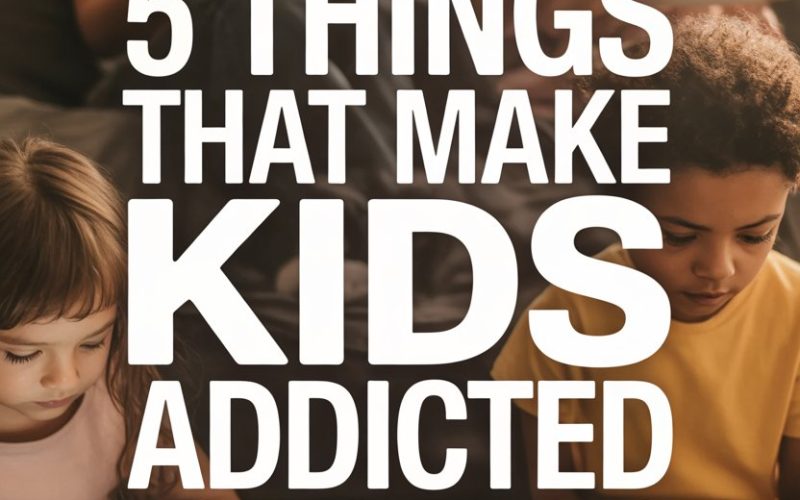Screen time. The phrase alone can make parents feel twitchy—somewhere between guilt and envy, with a side order of “Is it just my kid?” If only screens came with a volume knob and an off switch kids didn’t know about.
The truth: children’s love affair with screens is no accident. There are powerful forces at play (and no, it’s not just Minecraft’s fault).
Here’s what’s really going on behind those glued eyeballs and sticky fingers.
1. The Never-Ending Reward Loop
Anyone who’s tried to get a child off YouTube knows the struggle is real. Ask neuroscientists, and you’ll find the reason for the digital daze comes down to dopamine—a tiny chemical with a big job.
Every time your child unlocks a new level, scores a point, or watches a video that auto-plays, their brain gives them a hit of the good stuff: reward.
Video games and apps are designed like the world’s most persistent slot machines. They dangle rewards on a string, showering your child with confetti, stars, or digital unicorns for simply tapping the right button.
In fact, research shows that the endless feedback loop wires young brains for more, leading to compulsive use. (Curious about the science? This study on reward mechanisms outlines just how deliberate this design is.)
If you’re nodding along while scrolling through your own notifications—no judgement. The same principle keeps us hooked, just with more emails and fewer dancing llamas.
Tonight’s trick: Try setting screens to grayscale for a few hours. It’s as joyless as a salad at a birthday party, but it breaks the reward loop by draining those dopamine-triggering colours.
2. Social Connection Without the Stress
Remember whispering with friends behind a book or passing notes in school? Kids today slide into each other’s DMs, raid together in Roblox, and share memes that leave adults blinking in confusion.
The digital world offers instant connection—no need to wait for playdates or summon the courage to say hello in person.
For shy or anxious kids, this can be a blessing. Chatting online feels safer, less awkward. You can’t trip over your own words if you’re typing, right?
During lockdowns, screens were the only lifeline to mates and extended family. Now, even post-pandemic, online friendships have become the new default for many.
The trouble? Social apps are built for stickiness.
Likes, comments, and the eternal scroll of group chats keep them plugged in. The line between genuine friendship and digital popularity contest gets blurry, fast.
One approach for frazzled parents: Encourage screen-free hangouts, even if it’s just a walk with neighbours or inviting classmates over for pizza and messy crafts.
Remind your child that real-life belly laughs still beat emojis—plus, pizza can’t be downloaded.
3. Mastery and Agency Kids Crave
In digital worlds, kids get to be the captain, wizard, builder, or boss—usually a lot more impressive than “person who has to tidy their room.”
Games and apps offer a sense of mastery where effort equals progress, and the rules are clear (unlike, say, the mystery of when a parent will actually say yes to that extra biscuit).
A 10-year-old can build an empire in Minecraft, command a squad in Fortnite, or become a video star on TikTok—all places where their decisions matter.
Research from Common Sense Media shows that the thrill of control and achievement draws kids back again and again. Compare that to algebra, where you’re rewarded with… more algebra.
At home, look for ways to hand over the reins in the real world. Let them plan a family meal (yes, “cereal night” counts). Give them say over how their room looks, or what music plays in the car.
When kids taste agency offline, screens start to lose a bit of their shine.
4. Screens Fill Every Boredom Gap
Once upon a time, boredom meant stacking biscuits or inventing elaborate games with a bit of string. Now, the moment “I’m bored” escapes, a tablet appears like magic—faster than you can say “imaginative play”.
Screens have become the Swiss Army knife for parents. Need to keep a toddler quiet at the doctor? Fire up Peppa Pig. Stuck in traffic? There’s an app for that.
It’s the universal babysitter, distraction, and bribe, all rolled into one.
The problem isn’t the occasional episode of Bluey. It’s when kids no longer tolerate an empty moment without a screen to fill it.
Author and psychologist Dr. Shimi Kang warns that constant stimulation rewires young brains, making real-life downtime feel intolerable.
Try this on for size: Create a “boredom box” packed with puzzles, art supplies, or even old magazines. When the urge to reach for a device hits, suggest five minutes with the box before any screen switches flick on.
It might not buy you an hour, but it builds up that all-important boredom muscle.
5. Algorithms Know What Kids Like—Sometimes Too Well
If you’ve ever wondered how your child can watch one cat video and wind up three hours later learning how to juice an onion, thank the almighty algorithm.
Platforms like YouTube and TikTok are programmed to keep eyes glued and thumbs tapping by serving up one perfectly crafted recommendation after another.
These algorithms don’t just know what your child likes—they know exactly when they’re about to get restless or distracted. The more your child watches, the smarter the suggestions get, creating a personalised endless fairground of entertainment.
As The New York Times points out, kids’ viewing habits are shaped by invisible hands most adults don’t even understand.
Turning off “auto-play” is a simple but powerful move parents can make. It’s a digital speed bump, helping snap kids (and, let’s be honest, adults) out of the hypnotic scroll.
For younger children, switch to curated playlists or kid-friendly streaming platforms where the content ends—just like it did in the good old days of terrestrial telly.
Not All Doom and Zoom
Every parent knows the magnetic pull of screens isn’t going away. They’re not evil, and banning them outright only makes them more sparkly and forbidden.
The real win is helping kids spot the tricks screens use, so they can make smarter choices, and giving them a taste of agency, adventure, and real connection beyond the glass.
Tonight, try one tweak—maybe it’s a grayscale setting, maybe it’s a boredom box, maybe it’s just dinner with the phones out of sight. See what happens.
At the very least, you’ll have a new story to share—emoji not required.





